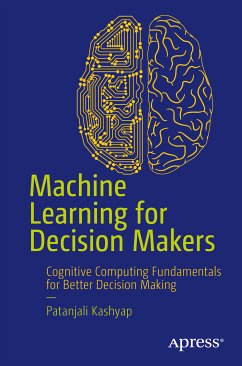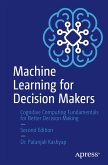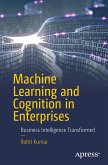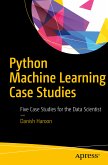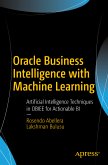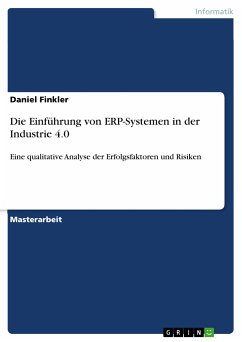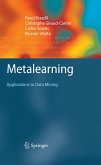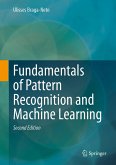Machine Learning for Decision Makers (eBook, PDF)
Cognitive Computing Fundamentals for Better Decision Making


Alle Infos zum eBook verschenken

Machine Learning for Decision Makers (eBook, PDF)
Cognitive Computing Fundamentals for Better Decision Making
- Format: PDF
- Merkliste
- Auf die Merkliste
- Bewerten Bewerten
- Teilen
- Produkt teilen
- Produkterinnerung
- Produkterinnerung

Hier können Sie sich einloggen

Bitte loggen Sie sich zunächst in Ihr Kundenkonto ein oder registrieren Sie sich bei bücher.de, um das eBook-Abo tolino select nutzen zu können.
Take a deep dive into the essential elements of machine learning. You will learn how machine learning techniques are used to solve fundamental and complex problems in society and industry. Machine Learning for Managers serves as an excellent resource for establishing the relationship of machine learning with IoT, big data, and cognitive and cloud computing. This book introduces a collection of the most important fundamental concepts of machine learning and its associated fields. These concepts span the process from envisioning the problem to applying machine-learning techniques to the…mehr
- Geräte: PC
- ohne Kopierschutz
- eBook Hilfe
- Größe: 4.81MB
![Machine Learning for Decision Makers (eBook, PDF) Machine Learning for Decision Makers (eBook, PDF)]() Patanjali KashyapMachine Learning for Decision Makers (eBook, PDF)43,95 €
Patanjali KashyapMachine Learning for Decision Makers (eBook, PDF)43,95 €![Machine Learning and Cognition in Enterprises (eBook, PDF) Machine Learning and Cognition in Enterprises (eBook, PDF)]() Rohit KumarMachine Learning and Cognition in Enterprises (eBook, PDF)43,95 €
Rohit KumarMachine Learning and Cognition in Enterprises (eBook, PDF)43,95 €![Python Machine Learning Case Studies (eBook, PDF) Python Machine Learning Case Studies (eBook, PDF)]() Danish HaroonPython Machine Learning Case Studies (eBook, PDF)60,95 €
Danish HaroonPython Machine Learning Case Studies (eBook, PDF)60,95 €![Oracle Business Intelligence with Machine Learning (eBook, PDF) Oracle Business Intelligence with Machine Learning (eBook, PDF)]() Rosendo AbelleraOracle Business Intelligence with Machine Learning (eBook, PDF)35,95 €
Rosendo AbelleraOracle Business Intelligence with Machine Learning (eBook, PDF)35,95 €![Die Einführung von ERP-Systemen in der Industrie 4.0 (eBook, PDF) Die Einführung von ERP-Systemen in der Industrie 4.0 (eBook, PDF)]() Daniel FinklerDie Einführung von ERP-Systemen in der Industrie 4.0 (eBook, PDF)36,99 €
Daniel FinklerDie Einführung von ERP-Systemen in der Industrie 4.0 (eBook, PDF)36,99 €![Metalearning (eBook, PDF) Metalearning (eBook, PDF)]() Pavel BrazdilMetalearning (eBook, PDF)40,95 €
Pavel BrazdilMetalearning (eBook, PDF)40,95 €![Fundamentals of Pattern Recognition and Machine Learning (eBook, PDF) Fundamentals of Pattern Recognition and Machine Learning (eBook, PDF)]() Ulisses Braga-NetoFundamentals of Pattern Recognition and Machine Learning (eBook, PDF)53,95 €
Ulisses Braga-NetoFundamentals of Pattern Recognition and Machine Learning (eBook, PDF)53,95 €-
-
-
- Discover the machine learning, big data, and cloud and cognitive computing technology stack
- Gain insights into machine learning concepts and practices
- Understand business and enterprise decision-making using machine learning
- See the latest research, trends, and security frameworks in the machine learning space
- Use machine-learning best practices
Dieser Download kann aus rechtlichen Gründen nur mit Rechnungsadresse in A, B, BG, CY, CZ, D, DK, EW, E, FIN, F, GR, HR, H, IRL, I, LT, L, LR, M, NL, PL, P, R, S, SLO, SK ausgeliefert werden.
- Produktdetails
- Verlag: Apress
- Seitenzahl: 355
- Erscheinungstermin: 4. Januar 2018
- Englisch
- ISBN-13: 9781484229880
- Artikelnr.: 53061023
- Verlag: Apress
- Seitenzahl: 355
- Erscheinungstermin: 4. Januar 2018
- Englisch
- ISBN-13: 9781484229880
- Artikelnr.: 53061023
- Herstellerkennzeichnung Die Herstellerinformationen sind derzeit nicht verfügbar.
He possesses a restless mind which is always looking for innovation and is involved in idea generation for all walks of life including spirituality, positive psychology, brain science and cutting-edge technologies. He is a strong believer in cross/ inter disciplinary study. His view of "everything is linked with the other" reflects in his work. For example, he has filed a patent on improving and measuring the performance of an individual by using emotional, social, moral and vadantic intelligence. Which presents a unique novel synthesis of management science, physics, information technology and organizational behaviour.
Patanjali has published several research and white papers on multiple topics. He is involved in a lot of organizational initiatives like building world class teams and dynamic culture across enterprises. He is a go-to person for incorporating"positivity and enthusiasm" in the enterprises. His fresh way of synthesizing "Indian Vedic philosophies with the western practical management insight for building flawless organizational dynamics is much appreciated in the corporate circle. He is a real implementer of ancient mythologies at modern work place. Patanjali is also involved in the leadership development and building growth frameworks for the same.
Apart from MCA patanjali holds masters in bioinformatics, physics and computer science (M.Phil.).
Chapter 2: Fundamentals of Machine Learning and its technical ecosystemChapter Goal: This chapter will explain the fundamental concepts of ML, Its uses in relevant business scenarios. Also takes deep die into business challenges where ML will be used as a solution. Apart from this chapter would cover architectures and other important aspects which are associated with the Machine Learning.No of pages: 40-50Sub - Topics1. Evolution of ML2. Need for Machine Learning3. The Machine Learning business opportunity4. Concepts of Machine Learning4.1 Algorithm types for Machine Learning4.2 Supervised learning4.3 Machine Learning models4.5 Machine Learning life cycle5. Common programing languages for ML6. Data mining and Machine Learning7. Knowledge discovery and ML8. Types and architecture of Machine Learning9. Application and uses of Machine Learning10. Tools and frameworks of Machine Learning11. New advances in Machine Learning12. Tenets for large scale ML applications13. Machine Learning in IT organizations14. Machine Learning value creation 15. Case study16. Authors interpretation of case studies17. Few professional point of views18. Mind map for the chapter19. Some important questions and their answers20. Your notes .... My notes21. Visual and text summary of the chapter22. Ready to use diagram for the decision makers23. Conclusion
Chapter 3: Methods and techniques of Machine LearningChapter Goal: This chapter will discuss in details about the common methods and techniques of Machine LearningNo of pages: - 40-50 Sub - Topics: 1. Quick look on required mathematical concepts2. Decision trees2.1 The basic of decision tree2.2 How decision tree works2.3 Different algorithm types in decision tree2.4 Uses and applications of decision trees in enterprise2.5 Get maximum out of decision tree3. Bayesian networks 3.1 The basics of Bayesian networks 3.2 Hoe Bayesian network works 3.3 Different algorithm types in Bayesian network 3.4 Uses and applications of Bayesian network in enterprise 3.5 Get maximum out of Bayesian networks4. Artificial neural networks 4.1 The basics of Artificial neural networks 4.2 How Artificial neural networks 4.3 Different algorithm types in Artificial neural networks 4.4 Uses and applications of Artificial neural networks in enterprise 4.5 Get maximum out of Artificial neural networks5. Association rules learning 5.1 The basics of Association rules learning 5.2 How artificial Association rules learning 5.3 Different algorithm types in Association rules learning 5.4 Uses and applications of Association rules learning in enterprise 5.6 Get maximum out of Association rules learning6. Support vector machines7. Few professional point of views on Machine Learning technologies8. Case study9. Mind map for the chapter10. Some important questions and their answers11. Your notes...my notes12 Visual and text summary of the chapter13 Ready to use diagram of the decision makers14 Conclusion
Chapter 4: Machine Learning and its relationship with cloud, IOT, big data and cognitive computing in business perspectiveChapter Goal: This Chapter will discuss briefly about Machine Learning associated technologies, like big data, internet of things(IOT), cognitive computing and cloud computing. Finally, I will conclude the chapter by establishing relationship among these.No of pages: 40-50Sub - Topics: 1. What is big about big data2. Introduction to big data concepts3. Big data technologies4. Big data solutions5. Fundamentals of cloud computing6. Cloud computing technology stacks7. Internet of things .... what is it all about8. IOT technology stack9. Modern solution architectures with real world IOT 10. Building blocks of cognitive computing 11. Big data and cognitive computing 12. Cloud and cognitive computing 13. Emerging cognitive computing areas 14. Putting it all together 15. Business insight 16. Business optimization 17. Case study 1 18. Case study 2 19. Authors interpretation of case studies 20. Some important questions and their answers 21. Few professional point of views 22. Mind map for the chapter 23. Your notes ...... My notes 24. Visual and text summary of the chapter 25. Ready to use diagram for decision makers 26. Conclusion
Chapter 5: Business challenges and applications of Machine Learning big data, IOT, cloud and cognitive computing in different fields and domains
Chapter Goal: This chapter will talk about business challenges associated with Machine Learning technologies and its solutions. Also discuss about few real time scenarios and used cases. Apart from this will throw light on application of ML across industriesNO of pages: 20-30Sub-Topics:1. Machine Learning and business value2. Drivers of business value3. Achieving customer delight and engagement with ML4. Responsive systems and ML5. Self-healing and Machine Learning6. How advance analytics will take you7. Case study- can we predict salary from historic data8. Case study-big data as a service9. Case study-connected cars10. Application of ML across industries10.1 Retail10.2 Airline10.3 Auto10.4 Financial services10.5 Energy10.6 Data Warehousing11. Few professional point of views on Machine Learning technologies12. Mind map for the chapter13. Some important questions and their answers14. Your notes ..... my notes15. Visual and text summary of the chapter16. Ready to use diagram for decision makers17. Conclusion
Chapter 6: Technology offered by different vendors for Machine Learning.
Chapter Goal: This chapter will discuss about the technology offering from different leading vendors and provide real time case studies, scenarios and point of viewsNO of pages: 20-30Sub-Topics:1. Machine Learning @ Microsoft2. Big Data @ Microsoft3. IOT @ Microsoft4. HDInsight and data analytics ... case study5. Cortana analytics suit- case study6. IBM Watson-Case study7. Cognitive internet of things -Case study8. Mind map for the chapter9. Some important questions and their answers10. Your notes .... My notes11. Visual and text summery of the chapter12. Ready to use diagram for decision makers13. Conclusion
Chapter 7: Security and Machine Learning
Chapter Goal: This chapter will discuss about role of Machine Learning in the areas of security in different fields and domainsNO of pages: 20-30Sub-Topics:1. How Machine Learning is reshaping security<2. Machine Learning forensics for law enforcement, security and intelligence3. Data mining and Machine Learning in cybersecurity4. Machine Learning approach to phishing detection and defense5. Mind map for the chapter6. Some important questions and their answers7. Your notes .... My notes8. Visual and text summery of the chapter9. Ready to use diagram for decision makers10. Conclusion
Chapter 8: Matrices, KPI's and more .... For Machine Learning ecosystemChapter Goal: This chapter will discuss about metrics, performance measures and KPI's for Machine Learning, big data, IOT, cloud and cognitive computing. Focus will be Machine Learning, however it summarizes the same for associated technologies as wellNO of pages: 20-30Sub-Topics:1. Machine Learning matrixes1.1 accuracy1.2 Confusion Matrix1.3 Prediction Threshold2. Big Data related performance matrix2.1 CPU time consumed2.2 I/O wait time2.3 Number of asynchronous prefaces2.4 Objects accessed2.5 Total elapsed time3. IOT related matrix3.1Mesuring all connected devices with IOT analytics 4. Cloud computing related matrix (generic) 4.1 Percentage of monitored applications 4.2 Percentage of apps met SLA 4.3 Average time to provision a node 4.5 Average time to deploy an application 5. Average delivery time of new products or services 6. Mind map for the chapter 7. Some important questions and their answers 8. Your notes .... My notes 9. Visual and text summery of the chapter 9.1 Ready to use diagram for decision makers 9.2 Conclusion Chapter 9: Best practices and pattern for Machine LearningChapter Goal: This chapter will discuss some relevant best practices and pattern for Machine Learning and allied technologies.NO of pages: 20-30Sub-Topics: 1. Network security best practice2. Data security and encryption best practices3. Identity management and access control security best practices4. Internet of things security best practices5. Best practices for software update on Microsoft Azure Iaas6. Azure boundary security best practices7. Mind map for the chapter8. Some important questions and their answers9. Your notes .... My notes10. Visual and text summary of the chapter11. Ready to use diagram for decision makers12. conclusion
Chapter 10: Recent advancement and future directions of Machine Learning
Chapter Goal: This chapter will discuss recent advancement and future directions of MLNO of pages: 10-20Sub-Topics:1. BOT Framework2. Case study - Microsoft chat BOT3. Case study - Google Sheri4. Microsoft Band5. Collaborative IOT6. Microsoft Cortana7. IBM Bluemix8. Amazon Alexa
Chapter 11: Conclusion
NO of pages: 3-5Sub-Topics:1.History and evaluation of Machine Learning2.Human brain, AI, Big data, Cognitive computing, cloud and Machine Learning3.Innovative new models and methodologies for Machine Learning4.Important questions and their answers for Machine Learning5.Further reading, bibliography, notes and references.
1.
Chapter 2: Fundamentals of Machine Learning and its technical ecosystemChapter Goal: This chapter will explain the fundamental concepts of ML, Its uses in relevant business scenarios. Also takes deep die into business challenges where ML will be used as a solution. Apart from this chapter would cover architectures and other important aspects which are associated with the Machine Learning.No of pages: 40-50Sub - Topics1. Evolution of ML2. Need for Machine Learning3. The Machine Learning business opportunity4. Concepts of Machine Learning4.1 Algorithm types for Machine Learning4.2 Supervised learning4.3 Machine Learning models4.5 Machine Learning life cycle5. Common programing languages for ML6. Data mining and Machine Learning7. Knowledge discovery and ML8. Types and architecture of Machine Learning9. Application and uses of Machine Learning10. Tools and frameworks of Machine Learning11. New advances in Machine Learning12. Tenets for large scale ML applications13. Machine Learning in IT organizations14. Machine Learning value creation 15. Case study16. Authors interpretation of case studies17. Few professional point of views18. Mind map for the chapter19. Some important questions and their answers20. Your notes .... My notes21. Visual and text summary of the chapter22. Ready to use diagram for the decision makers23. Conclusion
Chapter 3: Methods and techniques of Machine LearningChapter Goal: This chapter will discuss in details about the common methods and techniques of Machine LearningNo of pages: - 40-50 Sub - Topics: 1. Quick look on required mathematical concepts2. Decision trees2.1 The basic of decision tree2.2 How decision tree works2.3 Different algorithm types in decision tree2.4 Uses and applications of decision trees in enterprise2.5 Get maximum out of decision tree3. Bayesian networks 3.1 The basics of Bayesian networks 3.2 Hoe Bayesian network works 3.3 Different algorithm types in Bayesian network 3.4 Uses and applications of Bayesian network in enterprise 3.5 Get maximum out of Bayesian networks4. Artificial neural networks 4.1 The basics of Artificial neural networks 4.2 How Artificial neural networks 4.3 Different algorithm types in Artificial neural networks 4.4 Uses and applications of Artificial neural networks in enterprise 4.5 Get maximum out of Artificial neural networks5. Association rules learning 5.1 The basics of Association rules learning 5.2 How artificial Association rules learning 5.3 Different algorithm types in Association rules learning 5.4 Uses and applications of Association rules learning in enterprise 5.6 Get maximum out of Association rules learning6. Support vector machines7. Few professional point of views on Machine Learning technologies8. Case study9. Mind map for the chapter10. Some important questions and their answers11. Your notes...my notes12 Visual and text summary of the chapter13 Ready to use diagram of the decision makers14 Conclusion
Chapter 4: Machine Learning and its relationship with cloud, IOT, big data and cognitive computing in business perspectiveChapter Goal: This Chapter will discuss briefly about Machine Learning associated technologies, like big data, internet of things(IOT), cognitive computing and cloud computing. Finally, I will conclude the chapter by establishing relationship among these.No of pages: 40-50Sub - Topics: 1. What is big about big data2. Introduction to big data concepts3. Big data technologies4. Big data solutions5. Fundamentals of cloud computing6. Cloud computing technology stacks7. Internet of things .... what is it all about8. IOT technology stack9. Modern solution architectures with real world IOT 10. Building blocks of cognitive computing 11. Big data and cognitive computing 12. Cloud and cognitive computing 13. Emerging cognitive computing areas 14. Putting it all together 15. Business insight 16. Business optimization 17. Case study 1 18. Case study 2 19. Authors interpretation of case studies 20. Some important questions and their answers 21. Few professional point of views 22. Mind map for the chapter 23. Your notes ...... My notes 24. Visual and text summary of the chapter 25. Ready to use diagram for decision makers 26. Conclusion
Chapter 5: Business challenges and applications of Machine Learning big data, IOT, cloud and cognitive computing in different fields and domains
Chapter Goal: This chapter will talk about business challenges associated with Machine Learning technologies and its solutions. Also discuss about few real time scenarios and used cases. Apart from this will throw light on application of ML across industriesNO of pages: 20-30Sub-Topics:1. Machine Learning and business value2. Drivers of business value3. Achieving customer delight and engagement with ML4. Responsive systems and ML5. Self-healing and Machine Learning6. How advance analytics will take you7. Case study- can we predict salary from historic data8. Case study-big data as a service9. Case study-connected cars10. Application of ML across industries10.1 Retail10.2 Airline10.3 Auto10.4 Financial services10.5 Energy10.6 Data Warehousing11. Few professional point of views on Machine Learning technologies12. Mind map for the chapter13. Some important questions and their answers14. Your notes ..... my notes15. Visual and text summary of the chapter16. Ready to use diagram for decision makers17. Conclusion
Chapter 6: Technology offered by different vendors for Machine Learning.
Chapter Goal: This chapter will discuss about the technology offering from different leading vendors and provide real time case studies, scenarios and point of viewsNO of pages: 20-30Sub-Topics:1. Machine Learning @ Microsoft2. Big Data @ Microsoft3. IOT @ Microsoft4. HDInsight and data analytics ... case study5. Cortana analytics suit- case study6. IBM Watson-Case study7. Cognitive internet of things -Case study8. Mind map for the chapter9. Some important questions and their answers10. Your notes .... My notes11. Visual and text summery of the chapter12. Ready to use diagram for decision makers13. Conclusion
Chapter 7: Security and Machine Learning
Chapter Goal: This chapter will discuss about role of Machine Learning in the areas of security in different fields and domainsNO of pages: 20-30Sub-Topics:1. How Machine Learning is reshaping security<2. Machine Learning forensics for law enforcement, security and intelligence3. Data mining and Machine Learning in cybersecurity4. Machine Learning approach to phishing detection and defense5. Mind map for the chapter6. Some important questions and their answers7. Your notes .... My notes8. Visual and text summery of the chapter9. Ready to use diagram for decision makers10. Conclusion
Chapter 8: Matrices, KPI's and more .... For Machine Learning ecosystemChapter Goal: This chapter will discuss about metrics, performance measures and KPI's for Machine Learning, big data, IOT, cloud and cognitive computing. Focus will be Machine Learning, however it summarizes the same for associated technologies as wellNO of pages: 20-30Sub-Topics:1. Machine Learning matrixes1.1 accuracy1.2 Confusion Matrix1.3 Prediction Threshold2. Big Data related performance matrix2.1 CPU time consumed2.2 I/O wait time2.3 Number of asynchronous prefaces2.4 Objects accessed2.5 Total elapsed time3. IOT related matrix3.1Mesuring all connected devices with IOT analytics 4. Cloud computing related matrix (generic) 4.1 Percentage of monitored applications 4.2 Percentage of apps met SLA 4.3 Average time to provision a node 4.5 Average time to deploy an application 5. Average delivery time of new products or services 6. Mind map for the chapter 7. Some important questions and their answers 8. Your notes .... My notes 9. Visual and text summery of the chapter 9.1 Ready to use diagram for decision makers 9.2 Conclusion Chapter 9: Best practices and pattern for Machine LearningChapter Goal: This chapter will discuss some relevant best practices and pattern for Machine Learning and allied technologies.NO of pages: 20-30Sub-Topics: 1. Network security best practice2. Data security and encryption best practices3. Identity management and access control security best practices4. Internet of things security best practices5. Best practices for software update on Microsoft Azure Iaas6. Azure boundary security best practices7. Mind map for the chapter8. Some important questions and their answers9. Your notes .... My notes10. Visual and text summary of the chapter11. Ready to use diagram for decision makers12. conclusion
Chapter 10: Recent advancement and future directions of Machine Learning
Chapter Goal: This chapter will discuss recent advancement and future directions of MLNO of pages: 10-20Sub-Topics:1. BOT Framework2. Case study - Microsoft chat BOT3. Case study - Google Sheri4. Microsoft Band5. Collaborative IOT6. Microsoft Cortana7. IBM Bluemix8. Amazon Alexa
Chapter 11: Conclusion
NO of pages: 3-5Sub-Topics:1.History and evaluation of Machine Learning2.Human brain, AI, Big data, Cognitive computing, cloud and Machine Learning3.Innovative new models and methodologies for Machine Learning4.Important questions and their answers for Machine Learning5.Further reading, bibliography, notes and references.
1.
Es gelten unsere Allgemeinen Geschäftsbedingungen: www.buecher.de/agb
Impressum
www.buecher.de ist ein Internetauftritt der buecher.de internetstores GmbH
Geschäftsführung: Monica Sawhney | Roland Kölbl | Günter Hilger
Sitz der Gesellschaft: Batheyer Straße 115 - 117, 58099 Hagen
Postanschrift: Bürgermeister-Wegele-Str. 12, 86167 Augsburg
Amtsgericht Hagen HRB 13257
Steuernummer: 321/5800/1497
USt-IdNr: DE450055826
Bitte wählen Sie Ihr Anliegen aus.
Rechnungen
Retourenschein anfordern
Bestellstatus
Storno
Sollte Ihr Anliegen nicht dabei sein, finden Sie weitere Auskünfte zu Ihren Fragen auf unseren Serviceseiten.
Serviceseiten
Schließen
